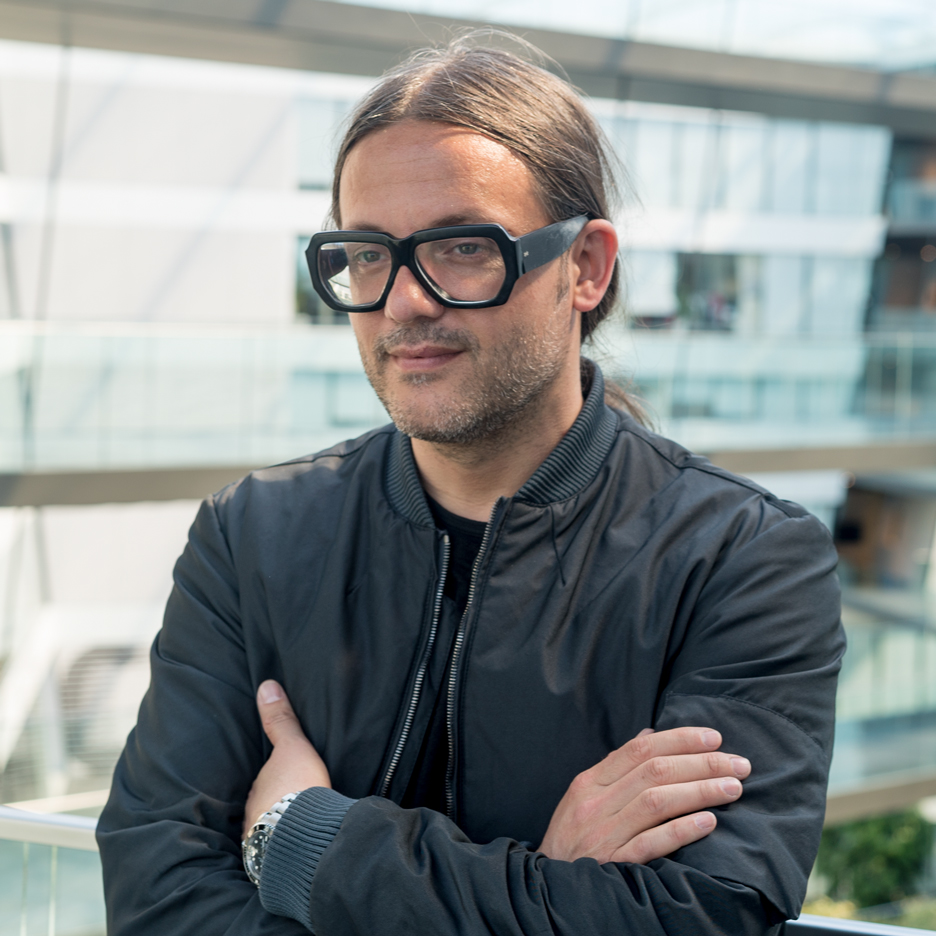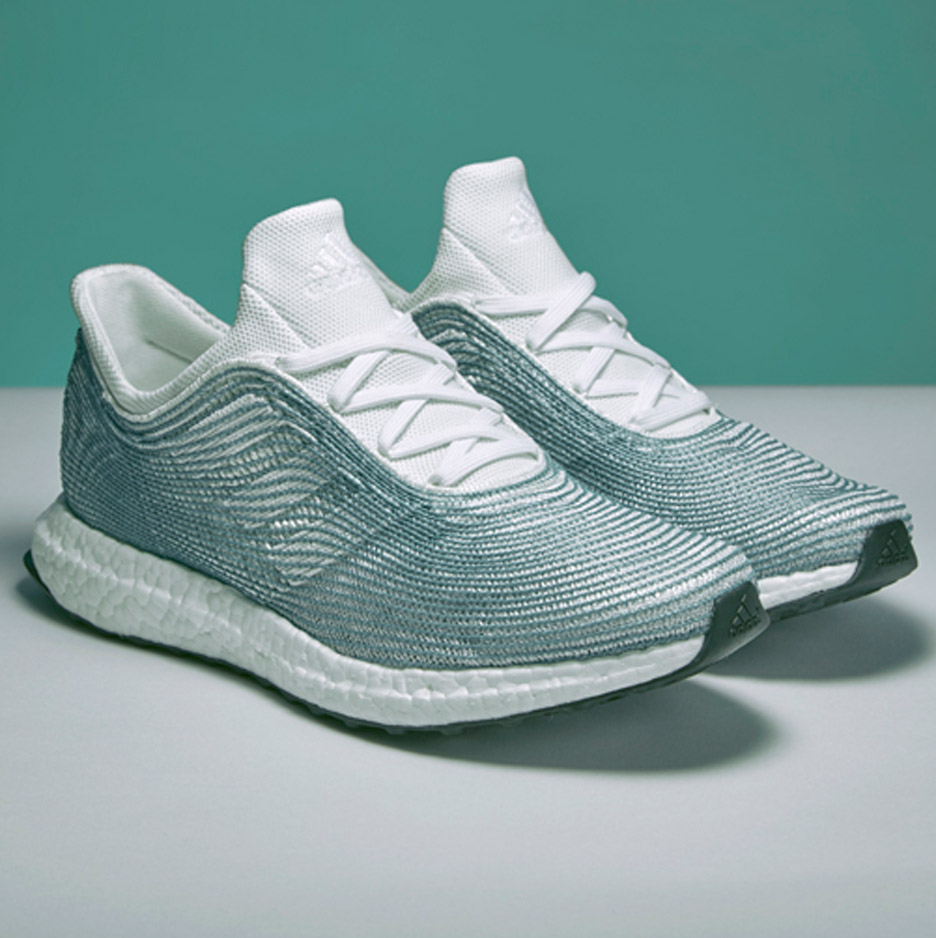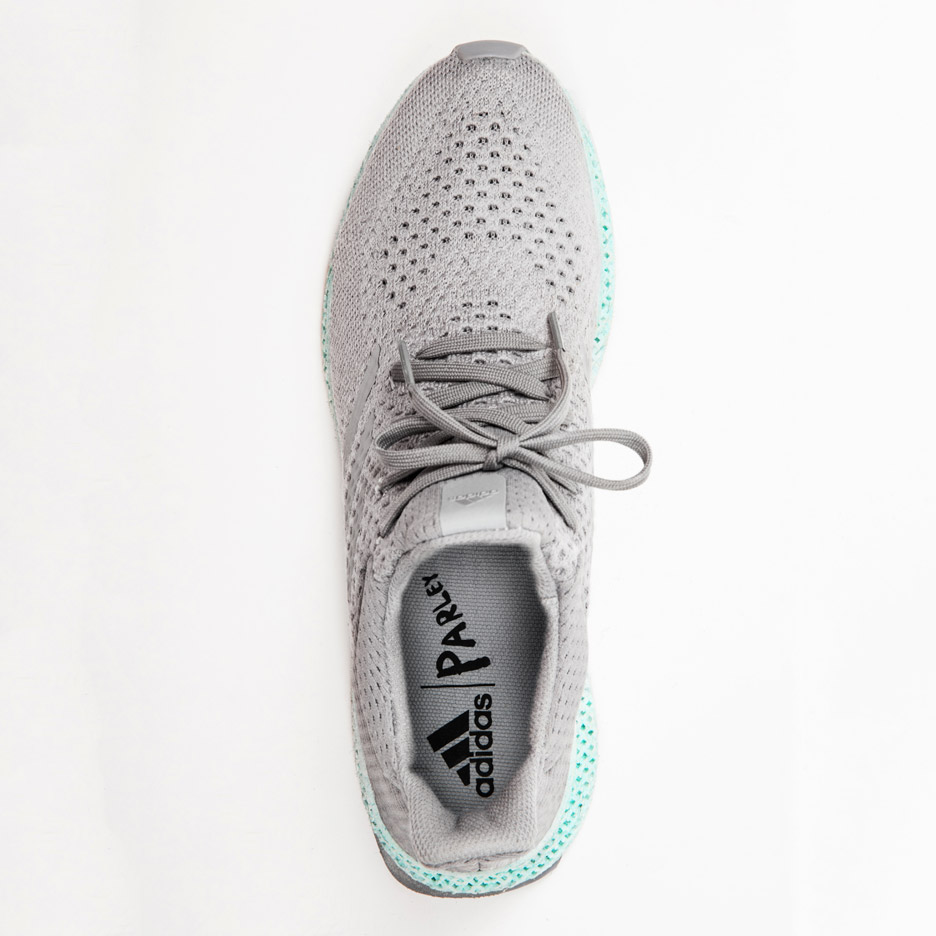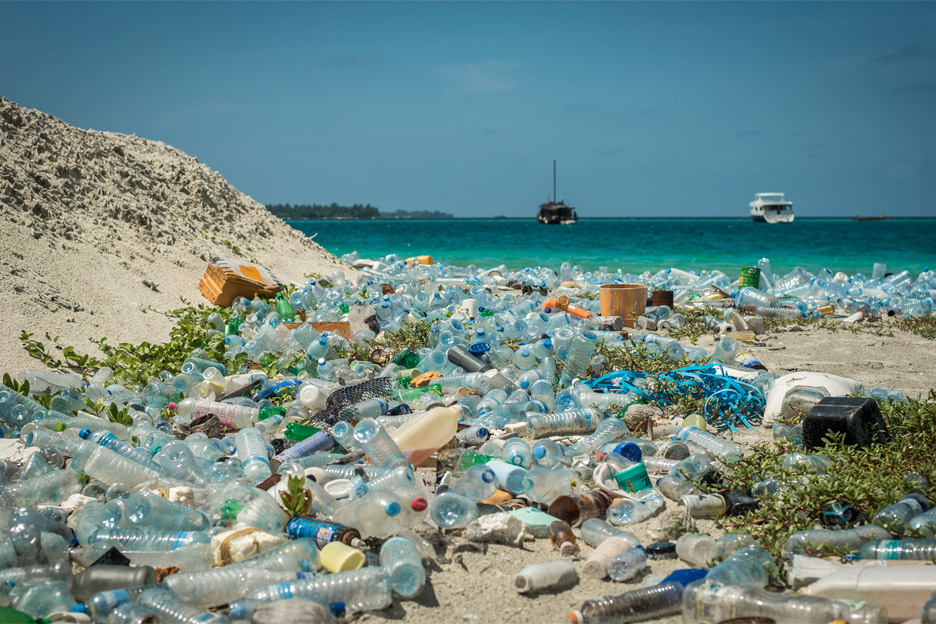"Plastic is a design failure" says Parley for the Oceans founder
Designers and brands need to wean themselves off the plastic "drug", according to Parley for the Oceans founder Cyrill Gutsch, who is releasing his organisation's shoes made from recycled ocean plastic with Adidas today (+ interview).
The Adidas x Parley shoes, designed by Alexander Taylor, were created using recycled plastic dredged from the oceans to raise awareness of the growing environmental issue.
"Our strategy to end plastic pollution is to recognise the problem and really accept that plastic is a design failure," said Gutsch, a former designer.
Gutsch said that designers needed to completely avoid using "virgin" plastic to help tackle the wider problem of plastic pollution.
"We are drug addicts, and you can't go clean and sober from heroin overnight," he said. "Recycled plastic is the substitute drug."

The German-born New Yorker learnt about the threat that ocean plastic poses to sea life from environmentalist Paul Watson in 2012.
Gutsch converted his agency from a design company to an environmental organisation "pretty much overnight". Now his Parley for the Oceans initiative aims to encourage other creatives to repurpose ocean waste, and come up with alternatives to plastic.
"We need to reinvent plastic," Gutsch told Dezeen at Parley's offices in New York. "We have to redesign the material, and question some of the product categories. We want to invent our way out of this."
"We created something that we call Parley Ocean Plastic, and a range of materials that is based on all that trash that we find in the sea and mixed with other recycled material, which makes it very very attractive for brands to use," he said.
The company has ongoing collaborations with brands including G-Star RAW, as well as the government of the Maldives, but chose German sportswear company Adidas as its first major partner.

The Adidas x Parley running shoes were first unveiled in July last year. They are made using the brand's existing footwear manufacturing process, but the yarns in the upper are replaced with fibres made from waste plastic. A version with a 3D-printed midsole created from recycled fishing nets was also revealed in December 2015.
"Everything that is synthetic is something that can be replaced with our plastic," said Gutsch. "We can do high-performance shoes, sports equipment, we can do fashion."
While recycling is a key part of helping to contain the issue, Parley's ultimate aim is to invent an environmentally friendly replacement for plastic.
"[Plastic] was not supposed to be out there in these quantities, it's just too successful, a mistake that became a superstar," said Gutsch.
The limited edition Adidas x Parley shoes are launching to coincide with World Oceans Day on 8 June 2016. Fifty pairs are up for grabs via an Instagram contest.
Read an edited version of the transcript from our interview with Cyrill Gutsch below:
Dan Howarth: What is your background?
Cyrill Gutsch: I'm a designer and strategist originally. I specialised in turning around brands or companies, or helping individuals to come out of a situation that was often unfortunate. Or to start new things where nothing is defined – there's just an idea and you want to create something out of it. A company, a brand, a product, whatever.
Dan Howarth: How did you come to start Parley for the Oceans?
Cyrill Gutsch: In 2012 I met Paul Watson, he was introduced to me by a mutual friend, who said: "here's the most legendary environmentalist. He's in trouble and I think you could help". He was arrested by the German government for fighting and confronting the Japanese whaling fleet, for putting his life and his fleet at risk, and for protecting whales by making their business very difficult to perform.
When I met him in Frankfurt in this little law firm I realised that I'm way more committed to the environmental cause than I ever saw. I was so busy making my own career and making money and winning awards and just ego-shooting in a way. I felt that I was prepared to take on a total different challenge, to own the territory of finding a solution for the oceans, fighting the environmental threats that we are facing right now.
This is unusual because as a creative you normally isolate yourself from all these pragmatic things. Its easy to go into this ivory tower and say "I'm just creating nice things, nice ideas, but other people implement it and I'm not responsible, they will know what to do."

Dan Howarth: What was your initial goal?
Cyrill Gutsch: I feel that the creative community has a very big responsibility to own the environmental cause and to make it a movement.
What made it urgent in that meeting was that Paul told me that there is a deadline – a point where all life in the oceans will pretty much collapse. That will be the year 2048, as predicted by two scientists Boris Worm and Ben Halpern. They made a forecast based on fishing and the increase in catching fish. They said: "if you continue at that speed, in 2048 the sea will be empty. We will not have any of the fish that we know now alive out there." Just shocking.
I converted from a design company to an environmental organisation pretty much overnight. My partners and I decided that we were going to stop what we do, and now fight for the sea and create a new form of an environmental organisation.
Dan Howarth: So your aim is to raise awareness of the issue?
Cyrill Gutsch: I think that became our number one mission at Parley, to make people understand the beauty and the fragility of the oceans.
The second vision is to come up with solutions. To cut this overwhelming problem down into smaller problems that no longer look so complex, that are no longer so impossible to solve.
You look at the oceans and there are so many threats – overfishing, illegal fishing, acidification, noise pollution, plastic pollution – its endless. We decided to go for plastic pollution because it is so easy to translate for us. It's so visual and non violent. Also, nobody would stop us. It's proven that we are destroying this planet with plastic trash. Back in 2012, it was less well known than it is today.
This plastic that we produce every day that we use then ends up in landfills or is being tossed into rivers or is tossed straight into the ocean – it all breaks down and it all ends up in the sea, in our food chain. Over 90 per cent of all fish that are caught today have traces of plastic. Even beer and salt have plastic traces. It's everywhere.

Dan Howarth: How are you trying to raise awareness of this?
Cyrill Gutsch: People can't deal with that information if you don't come up with an action plan and a solution that leads to a strategy. We felt like we had to develop a formula that was simple, which we called the AIR strategy. AIR means avoid, intercept and redesign, and you can apply that to everyday life.
Avoid plastic wherever you don't need it. It starts by just noticing that you're using it, that you are actually dealing with that trash in big quantities every day, observing how much packaging we create every day. Everyone can avoid plastic bags, straws, bottles.
As a designer you can translate that into professional life, creating products that don't use plastic, or use less plastic. If you can't cut down the amount then at least don't use virgin plastic, because we've produced enough plastic already for our planet and for mankind.
The second part is intercept. Be responsible for your trash. Take notice that you are making waste and be sure that it's not just landing somewhere. You can do that as an individual, or you can do it as a company – just be responsible for a product's end of life.
The R in AIR means you have to redesign everything that is a threat to our environment and our lives. Redesign the material. If you look at plastic, it is basically a design failure. It was not supposed to be out there in these quantities, it's just too successful, a mistake that became a superstar.
We need to reinvent plastic. That is the only solution. Of course we can try to recycle, but recycling fails. We can test it as much as we can, and avoid it as much as we can, but at the end of the day we have to redesign the material, and question some of the product categories. We want to invent our way out of this.
Dan Howarth: Tell me about your work with Adidas.
Cyrill Gutsch: Out of over 500 brands who wanted to work with us so far, we chose Adidas to be our founding partner at Parley. You need this one player in each segment in each category who redefines the rules, and we think Adidas is the one for us. The idea is to just question everything and rethink it, then to make it a big business.
If you thought the digital movement was big and disruptive, the environmental movement will disrupt everything, because there is a very clear deadline and the problems will be so big that we'll have to act. And at that moment, the players who are prepared for that will rule it. They will be ahead of the game because they will have already converted their factories, and already have the clients who want those new products.

Dan Howarth: What have you created together?
Cyrill Gutsch: Our first prototype is a shoe upper made from ocean plastic. Our strategy to end plastic pollution is to recognise the problem and really accept that plastic is a design failure, and to accept that the long term ambition must be to replace plastic. We are drug addicts, and you can't go clean and sober from heroin overnight. Recycled plastic is the substitute drug.
We created something that we call Parley Ocean Plastic, and a range of materials that is based on all that trash that we find in the sea and mixed with other recycled material, which makes it very very attractive for brands to use.
Dan Howarth: What items can you make out of this recycled plastic?
Cyrill Gutsch: The first thing we're doing is a high-performance sports shoe. A year ago we presented it as a concept, as the first result of our Adidas/Parley partnership. But now, it's not a concept anymore, it's a technology. We can do high-performance shoes, sports equipment, we can do fashion.
Everything that is synthetic is something that can be replaced with our plastic. We are not so interested in putting it into places where it doesn't belong. I feel still if you can avoid using plastic, that is better.
If we are to use synthetic materials because we want the attributes or the look or because we need it, then we can pretty much replace it. It can be fashion, it can be furniture, packaging for cosmetics or beauty products, any kind of hard plastics.
Dan Howarth: Where exactly does the waste plastic you use come from?
Cyrill Gutsch: Large quantities of fish nets that have been discarded by fishing fleets – a fish net that has been pulled out by our partner organisation Sea Shepherd. It is a 72-kilometre-long, illegal gill net.
A gill net is a mass-murder machine. It had been put on the bottom of the sea bed and it kills everything that passes by, but they only want to kill one fish known as the Chilean seabass. These guys pulled out the net, 70 tonnes of material. That is as complicated as it gets to retrieve it.
Then there is material that is floating around everywhere. It is very difficult to catch. It isn't big quantities, it's just little teaspoons full of stuff. But still we're catching and we are processing whatever we can.
The closer you come to the shore the easier it gets. There is all the material on the sea bed, in the reefs. Then you come to the ports and harbours. Then there are beaches, where tonnes of plastic trash is washed in from the sea or is tossed there by communities who often use beaches as dumping sites, or by tourists. That is easier to collect for us.
In coastal communities where people live, there is a lot of trash that they normally burn or bury, but there is not even a waste management system so it gets washed directly into the sea, or they just put it somewhere and the wind takes it. All very bad.
This is why we are focusing on islands at this point, because the main business is tourism there. They have a natural inbuilt motivation to protect their beaches. They don't like the trash, but they don't know how to solve it.
Dan Howarth: How is the waste plastic processed?
Cyrill Gutsch: All that trash gets accumulated and sorted and then compressed. We take it to our recycling facilities and break it down.
It doesn't make sense to ship containers around the world. You should process the trash on site, recycle it on site.
We really want to cut down the supply chain, its something we're going to present very soon. How we can shorten down the process of recycling and make it cheaper, because there is no reason why recycled material is more expensive than new virgin material.
Dan Howarth: Do you have any other upcoming collaborations?
Cyrill Gutsch: We have to announce partnerships with a huge furniture brand, with an automotive brand, with a fashion brand and with a government organisation.
Dan Howarth: What's the time scale of those announcements?
Cyrill Gutsch: The next two or three months. What we are announcing right now is our partnership with the Maldives.
We are presenting during this upcoming month our full strategy on ocean materials. It's a certification process where, every big factory on this planet can become a partner, and process our raw material that is fished out of the sea, mostly from island states.
The Maldives being our demonstration project, where we can end plastic pollution within the next five years if we implement our strategy, and we can use that material to tell others about the problem and to fund the programme.